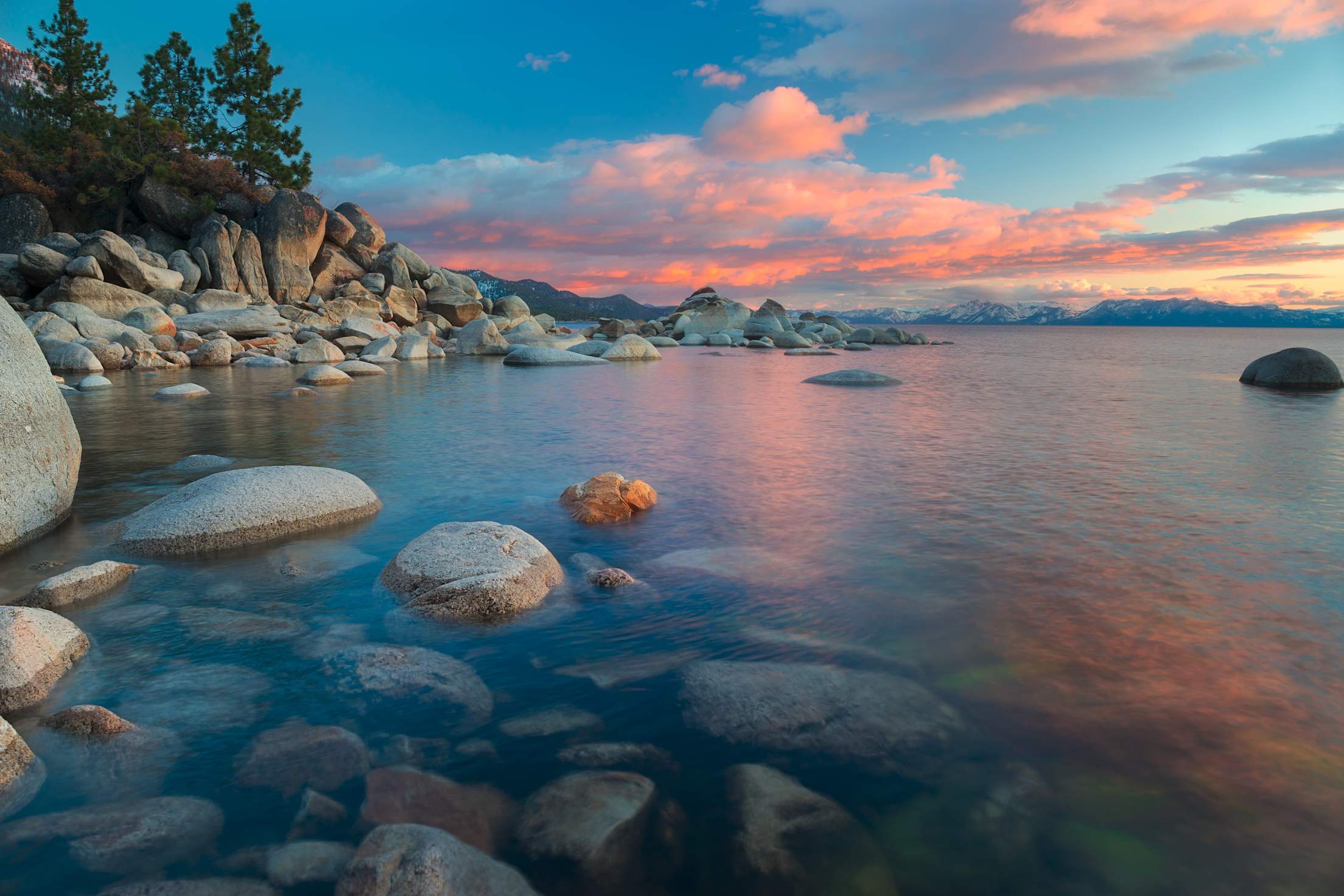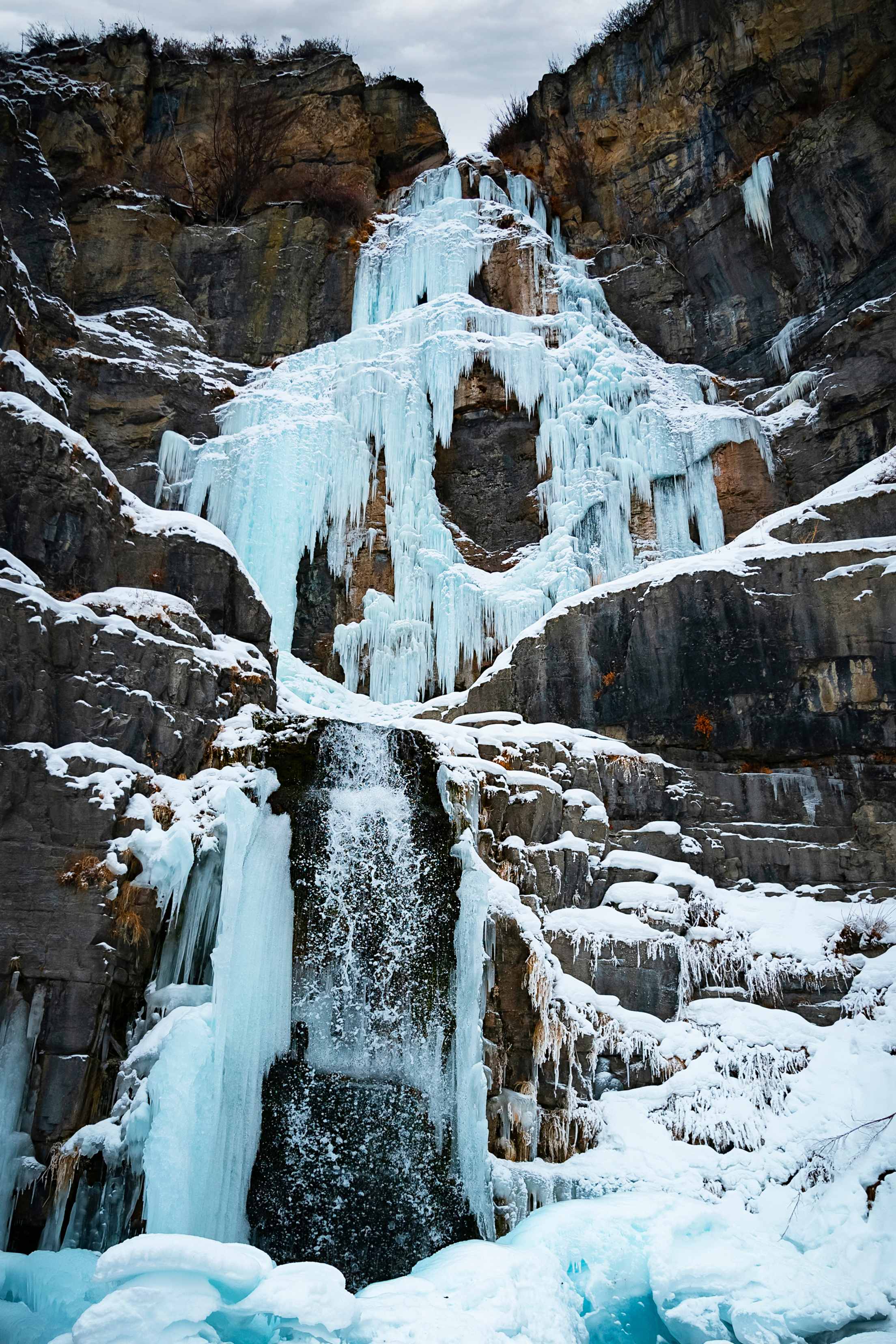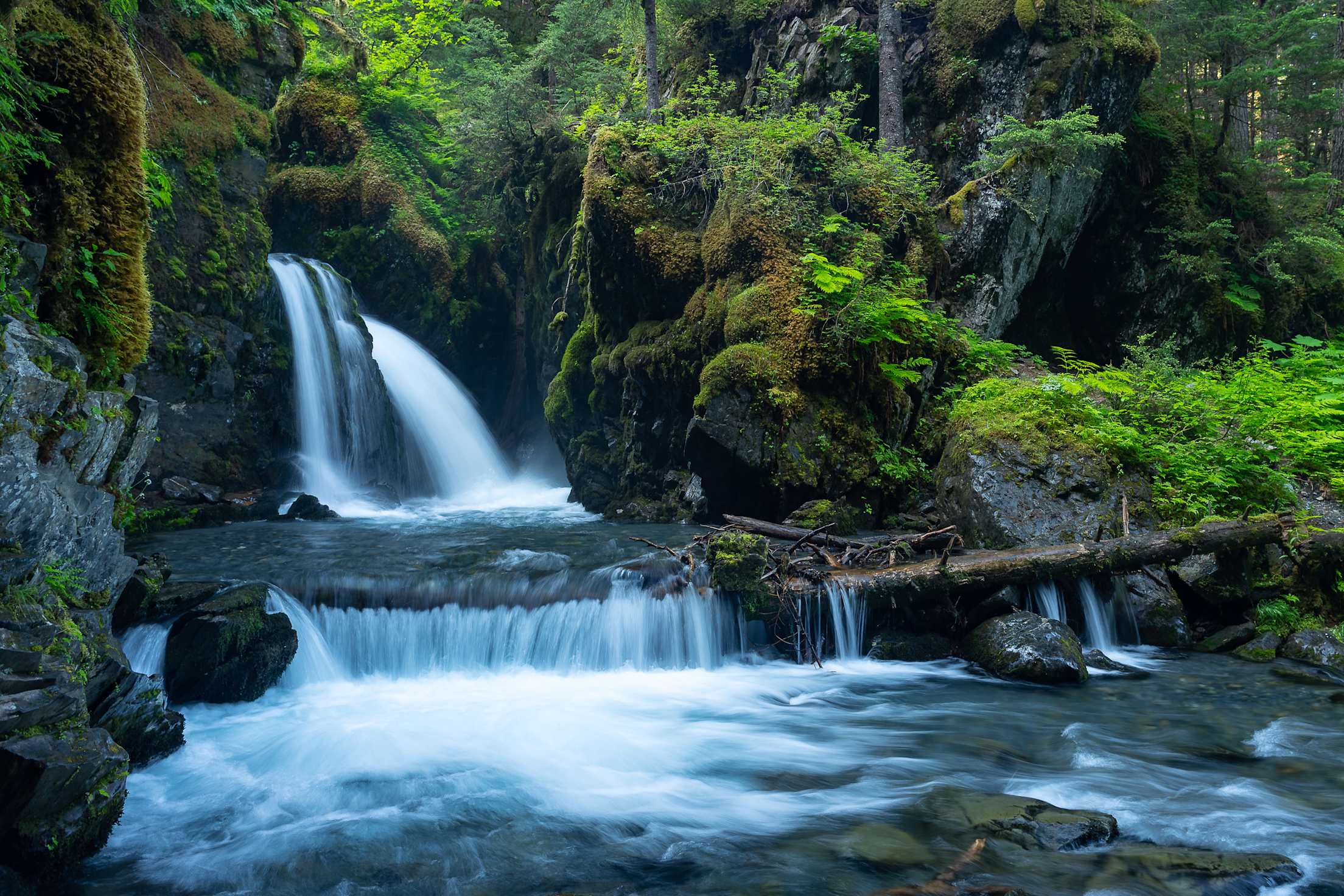
7 Scenic Waterfall Road Trips
The ultimate road trip prize? A stunning cascade. Here’s where to find them.

Sometimes, a road trip is about the journey and the destination. Each of these seven itineraries will deliver you to an incredible waterfall—with sweet surprises along the way.
San Francisco to McWay Falls
If Highway 1*—with its gorgeous cliffs, serpentine roads, and jaw-dropping views—is the greatest hits album of road trips, then Big Sur’s McWay Falls is the intoxicating moment when you hit the first chorus on the greatest of the greatest hits. Little wonder, then, that some 7 million people visit Julia Pfeiffer Burns State Park (home of the falls) each year. It’s 154 miles from San Francisco, so get an early start. Watch the fog burn off the green folds of the Coast Range as you drive south on Highway 280. Once you’ve left the bay behind, stop in Salinas, John Steinbeck’s old stomping grounds. Stroll the pretty Main Street, and pop into Emma’s Bakery & Cafe—a homey eatery opened by mother and son Emma Calderon and Eddie Estrada—for a toothsome twice-baked almond croissant or a slice of pie packed with local fruit.
From there, head out to Highway 1. As you roll down the coast, towering redwoods to your left and the wide blue Pacific to your right, you can’t help but feel inspired. Honor the bard of Big Sur at Henry Miller Library, where you’ll find a quirky bookstore, gallery, and performance space. Books hang from the rafters and portraits and sculptures abound. Inland, tucked along a 1.5-mile trail, Pfeiffer Falls** cascades down a rock face amidst the redwoods. Along the coast, McWay Falls plunges 80 feet, from those iconic coastal cliffs onto the beach below. Get a closer look from the 0.5-mile Waterfall Overlook Trail. Time your walk for late afternoon, when you just might catch the falls glowing gold in the setting sun.
*Editor’s Note: Julia Pfeiffer Burns State Park is open, but Highway 1 is closed from 6 miles south of the park to just north of Kirk Creek Campground. Motorists are advised to use an alternate route.
**The Pfeiffer Falls area is temporarily closed due to storm damage.

San Francisco to Russian Gulch Falls
Russian Gulch State Park’s allure isn’t new. A century ago, this stretch of coastline 157 miles north of San Francisco drew the attention of a Los Angeles property developer, who planned to build a resort there. Locals rallied to save the coastal headlands, stands of redwoods, and beautiful Russian Gulch Falls; in 1934, the area became a state park. To reach it, head north from San Francisco, savoring bay views as you roll through the crimson uprights of the Golden Gate Bridge. Wind through the tawny Sonoma hills, and stop on Santa Rosa’s south side in SOFA, a once-forgotten district, now abloom with art galleries and studios. Soak in the vibe at Café Frida Gallery, a father-in-law, son-in-law–owned joint, with colorful paintings on the walls and creative drinks on the menu. (We love their ginger latte, paired with the vanilla concha.) Mural gaze along Art Alley, then dip into Santa Rosa Arts Center to see paintings, drawings, and sculptures by Sonoma artists.
Continue north, heading through the Anderson Valley, out to Highway 1, and just past the town of Mendocino, to Russian Gulch State Park. The route to the falls is a choose-your-own-adventure, depending on which trails are open. The quickest way to the water? Park on Road 409 near Russian Gulch Horse Camp and take the 1.5-mile loop. The 36-foot cascade looks like something out of The Lord of the Rings: a frothy white curtain crashing down a rock face amidst verdant ferns, massive redwoods, and moss-fringed trees. If you can fit in another hike, head up the coast to Glass Beach. The trail to the beach is the busiest path in all of Mendocino; you’ll see why when you reach the famed cove, radiant with small, smooth pieces of clear, green, sapphire, and ruby-red sea glass: remnants of century-old trash, smoothed by the ever-churning tides. (Take as many photos as you please, but remember to leave these treasures in place for future visitors to appreciate.) It’s worth making reservations to stop at The Matheson on your way home. Opened by Bouchon alum Dustin Valette, the beautiful Healdsburg eatery serves an inspired menu. Toast your day of adventure with something special from the 450 bottle–deep wine list.

Reno to Hunter Creek Falls
Even when you’re standing beneath the blingy arch in the heart of the Biggest Little City in the World, you’re just 6.5 miles from a hike the Reno Gazette-Journal classifies as “mandatory Reno.” That would be the trail to Hunter Creek Falls, a 11-mile round-trip adventure that threads its way up a canyon, through a forest, and into the verdant bower sheltering the snowmelt-swollen falls. The 30-foot cascade burbles between two pine-covered hillsides, its waters tinging the rocks mossy green. It’s a striking sight in the high desert. Hunter Creek is a popular spot, and portions of the trail are quite exposed, so start early to beat the crowds and the heat.
That leaves you the afternoon and evening to explore Reno’s Midtown. Slung between South Virginia Street and Holcomb Avenue, this neighborhood has recently attracted a slew of driven creatives, who’ve breathed new life into old buildings. That spark is evident in the 80-plus murals gracing Midtown walls and alleys, from a woman’s face to a psychedelic octopus with long, besuckered tentacles. Treasure hunt using the Midtown Mural Map, or schedule a tour with an expert through Art Spot Reno or Pineapple Pedicabs. Save time for the area’s eclectic shops: Junkee Clothing Exchange overflows with wild costumes (hot pink fishnets, flapper dresses, rhinestone-encrusted sunglasses), while Recycled Records—purveyor of vinyl, CDs, and cassettes—urges customers: “Consider us your Obi Wan on your path to being a musical Jedi.” End the day at Icecycle Creamery. The must-try? Home Means Nevada: a sage ice cream with pine nuts, inspired by the flora of the Silver State.
Reno to Galena Creek Falls
A jaunt to Lake Tahoe is always a good idea, especially when a waterfall is involved. Start the day by heading south out of Reno and picking up the winding, lovely Mount Rose Highway. Make advance reservations to score a table at Sage Leaf Tahoe, an eatery in Incline Village owned by Lara and Shane Hammett, a couple who met while working at Yountville’s Napa Valley Grille. You’ll taste their bona fides in the sourdough French toast topped with lemon ricotta and blueberry compote, and the house-made sage and Cheddar biscuits served with salted butter, honey drizzle, and seasonal jam. After breakfast, backtrack up the Mount Rose Highway (aka State Route 431) to Galena Creek Falls loop, a 6-mile trail around Tamarack Peak. As you circle the mountain, the views shift, from panoramas of the Tahoe Basin to meadows painted in the summer with sunshine-yellow Tahoe Draba and pink, pom-pom–like Rose Buckwheat. Halfway into the hike, you’ll reach the delicate 70-plus-foot waterfall, which flows down the granitescape above you.

Want to learn more about the environment you’ve been exploring? Return to Incline Village and explore the UC Davis Tahoe Environmental Research Center. With an appointment, you can tour the research vessel and laboratory, wander the center’s upgraded working garden, and learn from a docent about how Lake Tahoe was formed, and why it’s so blue, anyway. Make your way to North Tahoe Beach, a pleasant park in Kings Beach, to watch the sunset over Big Blue. When you’re ready, hit the road for the 42-mile drive back to Reno.

Salt Lake City to Stewart Falls
In winter, Sundance Resort lures visitors with its champagne powder; come spring and summer, all that famous snow feeds two of Utah’s most striking cascades: Stewart Falls and Timpanogos Falls. Hit the I-15 early to make the 51-mile drive to Sundance and score parking. Aspen trees flank the 3.5-mile trail to Stewart Falls, snow-capped Wasatch peaks towering in the background. But no mountain vista can prepare you for the falls itself: a 200-foot chute plunging straight down a cliff face, sending up a refreshing spray at the base. If you have time, hike the 2.4-mile trail to nearby Timpanogos Falls, a long white ribbon of water cascading down a tiered rock face. Note: This area is prone to avalanches, so be sure to check the avalanche report before heading out.
Founded by Robert Redford, Sundance Mountain Resort has a serious commitment to the arts. See that passion in action at the Sundance Art Studio. Every first Saturday of the month, the sunlit space hosts a local artist, who does a live demonstration. The pieces in the gallery rotate, and there’s always something interesting on view, from a whimsical, lived-in space to an intricate sandstone carving. The studio also offers classes; register in advance, and you could spend two hours painting, making a leather-bound journal, or spinning pottery on the wheel. On your return, detour to Provo for dinner at Black Sheep Café. Opened by Bleu Adams and Jovanna Mason, who grew up on a Navajo reservation, the eatery fuses Native American and Southwestern cuisines to create a culinary language all its own. You might dig into hog jowl nachos, or savor a bowl of pozole. Whatever you order, we suggest pairing it with the house special: a cactus pear margarita.
Bozeman to Woodbine Falls
Everything in Montana exists on a supersize scale: the massive mountains, the wide-open valleys, the long, lonesome roads. The state’s waterfalls are no exception. At some 280 feet high, Woodbine Falls is one of the tallest of all. Fuel up for the 149-mile journey at Beacon Coffee Roasters. The friendly, sunlit shop just off the Montana State University campus takes its coffee seriously. Beans are sourced according to season and roasted on-site; syrups, such as lavender and turmeric-ginger, are made in-house. Pair your drink of choice with a blueberry goat cheese panini, made with the shop’s own goat cheese–cream cheese blend and house-made jam, the whole thing pressed into oozy, gooey deliciousness. After breakfast, jump on the 90 East and head for the Absaroka-Beartooth Wilderness. The scenes along the 1.4-mile Woodbine Falls Trail—lower elevation forests, with knobby granite peaks rising in the distance—call to mind the landscapes of Yosemite and Kings Canyon. (Like those parks, this area is well-loved, so help preserve the native vegetation by avoiding the temptation to cut corners on switchbacks.) Framed by high canyon walls with pine-covered mountains behind it, Woodbine Falls recalls another famous scene: the Grand Canyon of the Yellowstone.
Speaking of Yellowstone, stop in Livingston, one of the park’s gateway towns, on your return. The charming town has been around since the park’s early days. Neptune’s Taphouse & Eatery was born out of Livingston’s popular brewery, Neptune’s. The restaurant marries fresh-brewed beers with…sushi! The menu rounds up the usual suspects (veggie, salmon, and spicy tuna rolls), but also includes more adventuresome rolls, like the Birty Dird, featuring spicy tuna, avocado, jalapeño, and scallops. The fresh-brewed beers, meanwhile, harness regional ingredients such as Park County honey (Siren Song Honey Rye) and Yellowstone Coffee Roaster Coffee (Knotty Lotty Latte Stout).

Anchorage to Virgin Creek Falls
Cascading down a mossy cliff face, Virgin Creek Falls looks like something out of a fairy tale. And the road to get there, the Seward Highway, is just as stunning. Ensure you’re wide-awake for the scenery with a stop in Spenard at The Drip. Opened in 2020 by Anchorage native Mychal Moore and her husband Rafael, the friendly shop has an epic syrup selection, with flavors essential (salted caramel) and esoteric (red velvet). Coffee in hand, head south on the Seward Highway, marveling at the Kenai Mountains and their reflections in the waters of the Turnagain Arm.
For leisurely viewing of the waterway—and the birds flying over it—stop at the Potter Bird Marsh Sanctuary. Then, continue to the resort town of Girdwood. The town’s Alyeska Mountain receives a whopping 600 inches of snow annually; you’ll see the results on the Virgin Creek Falls Trail, in the soaring birches and spruce, the clutches of periwinkle forget-me-nots, and the flourishing ferns. The path is just a half-mile round-trip, so take your time admiring the cascade. Keep an eye, too, for birds: The trail is located in the Chugach National Forest, which is home to 214 species of residential and migratory species, including the bald eagle, the downy woodpecker, and Alaska’s state bird, the ptarmigan. Even more wildlife awaits just down the road, at the Alaska Wildlife Conservation Center. The nonprofit takes in injured and orphaned animals, giving them room to roam on their 200-acre grounds. Walk the sanctuary’s 1.5-mile loop, and you’ll see creatures ranging from the massive musk ox to the pint-sized porcupines. As part of its education mission, AWCC hosts free daily programs highlighting various animal residents. Catch one if you can, and be sure to give your regards to the wood bison—a rare creature which the center helped reintroduce to the wild.